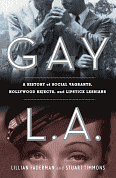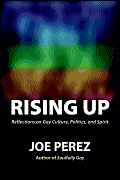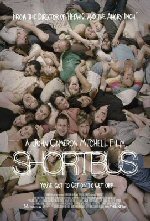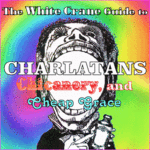 Gay L.A.
Gay L.A.
A History of Sexual Outlaws,
Power Politics, and Lipstick Lesbians
By Lillian Faderman and Stuart Timmons
Basic Books (Perseus Books Group) 2006
ISBN -13978-0-465-02288-5
431 pages, $27.50
Reviewed by Bo Young
If you stopped the average, well-read gay man on …say, Castro Street or Eighth Avenue Chelsea or even Santa Monica Boulevard (can you find “well-read” gay men on any of those streets?) and asked them where the modern Gay liberation movement got its start, it’s a safe bet the majority of responses would be something about Stonewall and New York City. Such is the power of publicity (and urban density, according to Gay L.A. authors, Faderman and Timmons). Because, in a fair appraisal of the developments of what might be called GLBT history, Los Angeles would necessarily play a major, if not the starring role. By any measure of “apples and oranges” Los Angeles and its cultural contributions to GLBT Liberation was ahead of the curve and ahead of New York City.
This, of course, sticks in the craw of a lot of city chauvinists. But facts are facts. If you trace modern Gay liberation back to the Harry Hay and Rudy Gernreich and their circle that became the Mattachine Society, you will find yourself in the sunny climes of Southern California. And if you want to talk about “riots” that resulted in gay people organizing, we’re not in Greenwich Village, 1969, anymore, Toto, we’re on Cahuenga Boulevard in Los Angeles; and 1967 is a full two years earlier.
When the religious fundies started their goose-stepping, church-state, church-state, church-state march across the country from Dade County, it was the political savvy of Southern California that made them break their stride, at least for the time being. It was not, for example, as legend and hagio-documentary would have it, Harvey Milk single-handedly standing up to Anita Bryant. In fact, as this reviewer remembers the story (and I was, in fact, the Assistant State Press Secretary to the great Sally Fiske on the No On 6 campaign in So-Cal) the job was to keep Harvey away from microphones, so as to allow John Briggs to hoist himself by his own language petard.
Lillian Faderman and Stuart Timmons, the co-authors of Gay L.A., have written an entertaining and fascinating history of, yes, GLBT people in Los Angeles — Gay people, lesbians, two spirits, drag queens, wayward sailors and closeted leading actors, and other assorted sexual outlaws, as the subtitle promises. In a most, for Los Angeles, unusual self-effacing way, the collective march-of-time stories make a serious argument for Los Angeles’ honored place in the history of Gay people in America.
If the time line the authors relate is necessarily limited in its depth — and it is — it is also nothing short of dazzling in its breadth. In fairness, much like getting around L.A. by highway, there is a good deal of ground to cover, and having personally lived through a number of the stories related regarding the halcyon disco days (your humble reviewer was doorman at the Cabaret/After Dark disco in S.F.) and bathhouse bacchanalia of the late 70s (every Monday, said reviewer took Sheldon Andelson’s 8709 receipts to the gay-owned bank he and others started in L.A.) and the political and medical dramas of the early 80s (and slept with his share of the main characters…which he will most certainly not review here) this writer can personally attest to there being a good deal more to tell. But again, in fairness, probably any one of the chapters in the book could be expanded into a stand-alone book. And probably will.
Given this, the range of stories — from pre-publicist times of indigenous Chumash Two Spirit culture, (when the name of the place was translated as “the smoke” because of the environmental peculiarities of the geography), to the modern political action and multicultural influences of this smoggy Hollywood dream citym — makes the book laudable. The writing partnership of Lillian Faderman and Stuart Timmons offers a tasty combination of women’s stories — I suspect in her voice — as well as the men’s — in his. Rising above male/female binaries, they have made an equally concerted effort to tell the multicultural rainbow of stories, all without the feeling of forced PC-ness, feeling more like what political correctness really is meant to be: the whole story with respect to all the players. It is heartwarming to see the names of Gayle Wilson, Sally Fiske, Roberta Bennett, Diane Abbit and Valerie Terrigno brought to the worthy fore, to say nothing of better known names like Jean O’Leary, Ivy Bottini, Colt handsome Steve Schulte and Mixner with the name Scott appended to it. These were people and stories I knew personally and they are well-honored and well-served here.
Despite my own personal history there, I was…and I think most readers will find themselves…surprised, really, at the not merely important role Los Angeles has had in GLBT history, but the very central, truly groundbreaking force and fertile ground it has been. This is a much needed addition to and clarification of the national history of our struggle that should sit proudly on any bookshelf right next to David Carter’s Stonewall.
This is just an excerpt from this issue of White Crane. We are a reader-supported journal and need you to subscribe to keep this conversation going. So to read more from this wonderful issue SUBSCRIBE to White Crane. Thanks!











